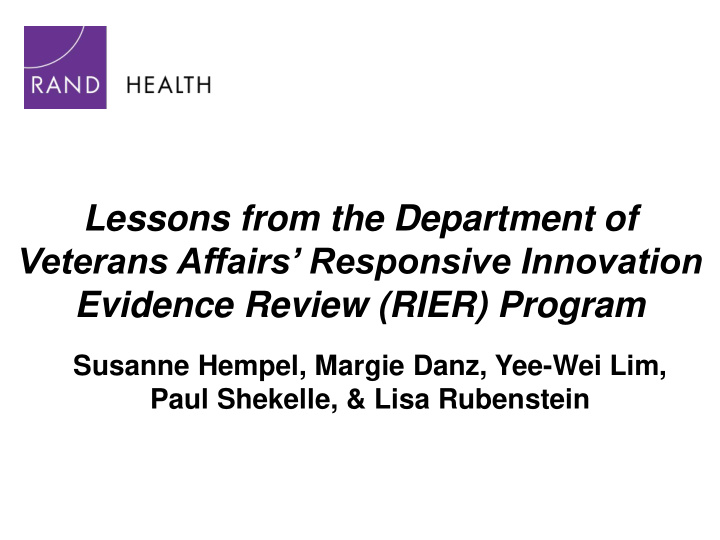



Lessons from the Department of Veterans Affairs’ Responsive Innovation Evidence Review (RIER) Program Susanne Hempel, Margie Danz, Yee-Wei Lim, Paul Shekelle, & Lisa Rubenstein
Context • VISN 22 - VAIL/PACT Site – Desert Pacific Healthcare Network (VISN 22) – Veterans Assessment and Improvement Laboratory (VAIL) – Patient Aligned Care Teams (PACT) • Funded by the VA Office of Patient Care Services • Innovation teams – Evidence-Based Quality Improvement initiative – Redesign of primary care • Evidence review team – Evidence-based Practice Center (EPC) staff • Located at RAND • Systematic reviewers, librarian, project assistance
Rationale • Large number of tested approaches to improve quality of care – Knowledge translation • Innovation teams – Committed to Evidence-Based Quality Improvement – Research volume and access increases steadily – Need for valid summary of the evidence • Evidence review team – Expertise in comprehensive literature searches – Used to synthesize large bodies of evidence – EPC staff objective, no preference or bias – Transparent documentation techniques
Service • Responsive Innovation Evidence Review (RIER) – Responsive to innovators’ needs • Specific audience target – Process started with initial review request • Engaging practitioners to identify evidence needs – Questions beyond general effectiveness • Evidence requests included effectiveness, but also implementation tools, costs, locally important aspects – Rapid review • Completed between 2-6 weeks • Cost-effective methods • Highly structured, 6-15 pages long
Responsive Evidence Review Topics – Advanced Access – Self-Management – Homelessness – Motivational Interviewing – PCMH Evaluation Measures – Interactive Communication – Patient Registries – Role of Nursing – PCMH and Mental Health – Clinician Burnout – Pharmacists – Guided Imagery – Primary Care Team – Resident Training Functioning – Medication Renewal – Readmissions – Measuring Homelessness – Relational Coordination – Provider Continuity – Secure Messaging
Methods • Stakeholder engagement – Request form developed to clarify innovator needs – Review questions established together with innovators • Search methods – Filters (PCMH search filter, PubMed Clinical Query) – Sources (SR databases, grey literature resources) – Strategy (e.g., PubMed Similar Article function) • Valid overview – Use of systematic reviews – Meaningful literature sampling – Emphasis on most relevant evidence
Dissemination • Transparent, structured reporting – Background, key messages, further reading – Methods section – Evidence table • Dissemination – Short reports, handouts for meetings, slide decks – Intranet site, conference brochure – Handout “Quick guide to the literature” • Where to look, how to search, what to look for, what to consider, how to summarize a body of evidence
Evaluation • Interim evaluation – Satisfaction with service – Need for process improvement • DOI: 10.13140/RG.2.2.17346.38086 • Final project evaluation – Feasibility, usability, process, format • Incorporating evidence review into innovation • Evidence-Based Quality Improvement – http://dx.doi.org/10.1136/bmjqs-2012-001722 • Remaining open question – Impact evaluation
Recommend
More recommend